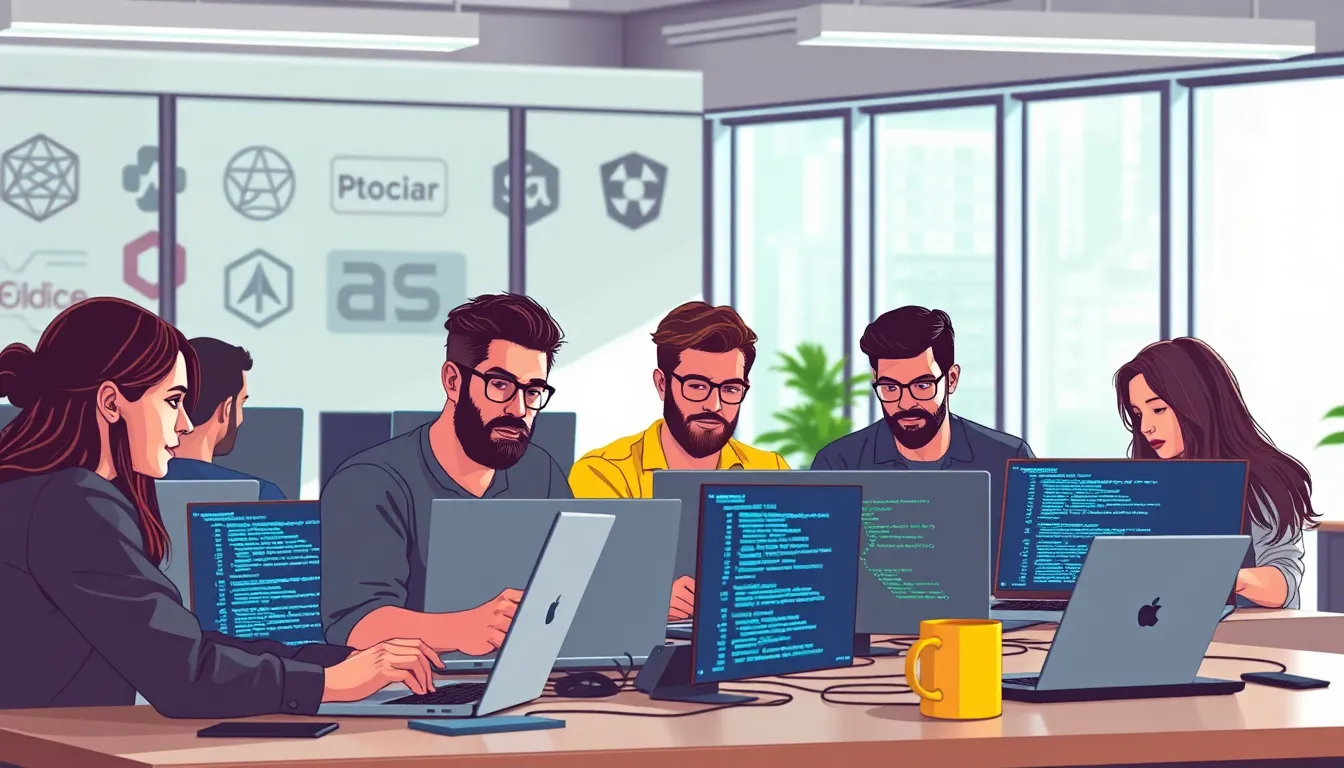In a world where government services often feel like navigating a labyrinth blindfolded, govtech services are the shining beacons guiding us through. These innovative solutions are here to rescue citizens from the clutches of red tape and inefficiency, making interactions with government a breeze rather than a headache. Imagine a world where filing taxes or applying for permits is as easy as ordering a pizza—now that’s a slice of heaven!
Govtech isn’t just about tech for tech’s sake; it’s about transforming the way citizens engage with their government. With user-friendly platforms and data-driven insights, these services promise to turn the bureaucratic slog into a smooth ride. So, buckle up and get ready to explore how govtech services are revolutionizing public administration and making life just a little bit easier for everyone involved.
Table of Contents
ToggleOverview of Govtech Services
Govtech services encompass various innovative technologies aimed at enhancing citizen engagement with governmental operations. These services streamline complicated processes such as tax filing, permit applications, and accessing public records. By employing user-friendly digital platforms, citizens can navigate government services with ease.
Data-driven insights play a crucial role in shaping govtech solutions. Analytics enable governments to understand citizen needs, leading to improved services. Real-time feedback mechanisms further empower users to influence service delivery actively.
Moreover, automated systems reduce the redundancy often seen in traditional bureaucratic processes. Automation not only saves time but also minimizes human error in data processing. Through cloud solutions, governments ensure that services remain accessible anytime and anywhere, even from mobile devices.
Security remains a top concern for govtech services. Robust cybersecurity measures protect sensitive information, building trust between citizens and government entities. Transparency features within these platforms allow citizens to track their applications and obtain real-time updates.
Collaboration with private sector partners enhances service offerings, often providing cutting-edge tools that the public sector may lack. Startups and tech companies contribute new ideas and innovations, enriching the overall ecosystem of public services.
Incorporating citizen feedback into the development of new applications increases usage rates. Engaging citizens in the design process addresses their actual needs, resulting in more effective public services. With the evolution of technology, govtech services continue to transform the relationship between citizens and their governments.
Benefits of Govtech Services

Govtech services offer significant advantages for both citizens and governments. These benefits include improved efficiency and enhanced transparency.
Improved Efficiency
Govtech services streamline processes, allowing government operations to run smoothly and effectively. Automating routine tasks reduces manual work, minimizing delays. Enhanced data management leads to quicker decision-making. Streamlined workflows simplify interactions, enabling citizens to access services faster. Implementing cloud solutions ensures these services are available from any device, fostering accessibility. Shorter wait times for permits or licenses result in increased citizen satisfaction. Using data analytics helps identify bottlenecks in processes, allowing governments to respond effectively. Efficient service delivery ultimately reflects a government’s commitment to improving public administration.
Enhanced Transparency
Govtech services promote transparency in governmental operations, cultivating trust between citizens and public officials. Providing real-time access to information allows citizens to track service requests. Open data initiatives empower individuals to understand government spending and decision-making processes. Visualizing complex data fosters clearer communication regarding government actions. Feedback mechanisms encourage citizen participation in policy development, ensuring their voices are heard. Sharing performance metrics enhances the accountability of government agencies. Transparent practices encourage responsible stewardship of public resources, strengthening the relationship between citizens and their governments.
Types of Govtech Services
Govtech services encompass various solutions that enhance government operations and citizen engagement. These services include digital identity solutions, e-government platforms, and data analytics and management systems.
Digital Identity Solutions
Digital identity solutions explore secure methods for citizens to access government services. They streamline verification processes by providing unique digital identities that authenticate users quickly. These systems increase security while reducing fraud risks. Citizens benefit from a seamless experience when accessing services like voter registration or tax filing. Multiple government agencies can share verified identities, enhancing service delivery and ensuring data protection.
E-Government Platforms
E-government platforms facilitate online interactions between citizens and their governments. These platforms allow users to complete tasks like permit applications and tax returns from any device, increasing convenience and accessibility. Local and state governments leverage these platforms to enhance communication, share information and notify citizens of important updates. By simplifying bureaucratic processes, e-government platforms improve efficiency and user satisfaction. They enable real-time updates and tracking for applications, fostering transparency throughout the process.
Data Analytics and Management
Data analytics and management elevate the decision-making capabilities of government agencies. They provide insights into citizen needs and service usage patterns, helping agencies identify areas for improvement. Advanced analytics tools process large datasets efficiently, supporting evidence-based policy development. Management systems facilitate data storage and sharing between agencies, promoting collaboration. By utilizing analytics, governments can respond proactively to citizen feedback, ultimately leading to enhanced public services and increased trust.
Challenges in Implementing Govtech Services
Implementing govtech services presents multiple challenges that can hinder their effectiveness.
Budget Constraints
Limited budgets often restrict the adoption of advanced technologies. Many government agencies operate under tight financial conditions, which can delay digital transformation initiatives. Allocating funds toward new technology while addressing ongoing operational costs creates tension in budget management. Prioritizing essential services sometimes leaves little room for innovative projects. Small agencies face even greater obstacles, as they may lack adequate financial resources to invest in comprehensive solutions. In many cases, securing funding requires demonstrating potential returns on investment, adding pressure to prove value before implementation. Ultimately, effective planning and collaboration with stakeholders play crucial roles in overcoming these financial barriers.
Technology Adoption
Resistance to change complicates technology adoption within government agencies. Staff members may be hesitant to use new systems due to fear of the unknown. Training programs must address skill gaps and provide ongoing support to ease the transition. Lack of familiarity with digital tools can lead to reduced employee engagement in the adoption process. Additionally, outdated infrastructure can impede efforts to implement modern solutions, as compatibility issues arise. Stakeholders should involve employees in the decision-making process to foster a culture of innovation. Building a strong case for the benefits of new technology helps cultivate buy-in among users. Fostering open communication between agencies and employees smooths the implementation path for govtech services.
Future Trends in Govtech Services
Govtech services continue to evolve, driven by innovation and the need for improved public administration. The following trends highlight how these services adapt to future demands.
Integration with Emerging Technologies
Integration of artificial intelligence boosts the efficiency of govtech services. Solutions that leverage machine learning streamline data analysis, enabling quicker decision-making. Blockchain technology enhances security and transparency, safeguarding citizen data while reducing fraud risk. Additionally, Internet of Things devices facilitate real-time data collection, providing agencies with valuable insights into community needs. Augmented reality applications can visualize information, helping citizens understand complex data. These integrations not only enhance operational capabilities but also foster trust between governments and citizens.
Focus on Citizen Engagement
Engagement strategies center around enhancing citizen interactions with government services. User-friendly applications prioritize accessibility, making it easier for individuals to access necessary information. Real-time feedback mechanisms encourage community involvement in decision-making processes, ensuring that services meet citizen expectations. Data analytics reveal trends in citizen behavior, allowing governments to tailor services accordingly. Gamification techniques can incentivize participation, making civic engagement more appealing. Proactive communication builds a sense of community and encourages collaboration between governments and their constituents, creating a more responsive and accountable public service landscape.
Govtech services are reshaping the landscape of public administration by enhancing interactions between citizens and government. With a focus on user-friendly solutions and data-driven insights, these services streamline processes and improve efficiency.
As technology continues to evolve, the integration of advanced tools like artificial intelligence and blockchain will further enhance security and transparency. By prioritizing citizen engagement and feedback, governments can build trust and foster a collaborative environment.
Embracing these innovations not only simplifies bureaucratic procedures but also empowers citizens, leading to a more responsive and accountable public service. The future of govtech promises to transform the way citizens connect with their governments for the better.






